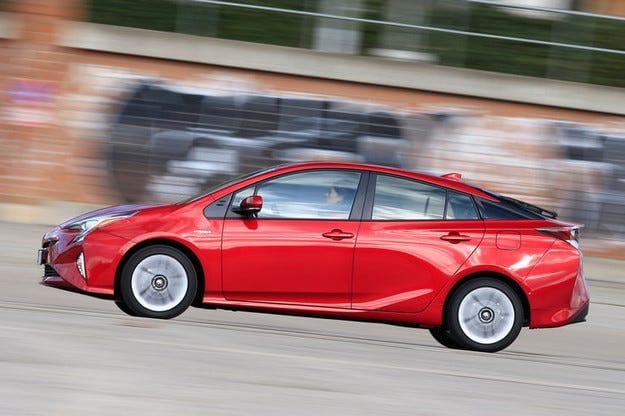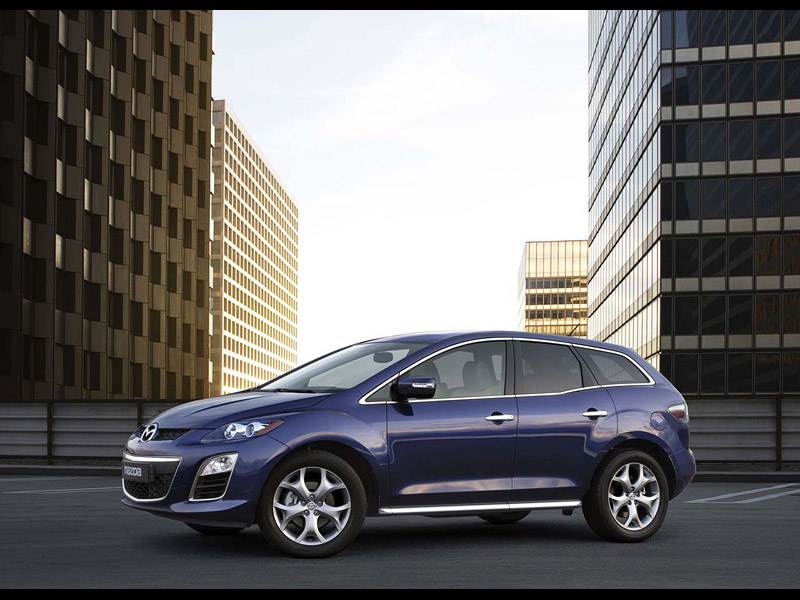
Test drive Toyota Prius: the pleasure of saving
Content

Test of the fourth generation of the pioneer among serial hybrids
For Prius buyers, only the lowest possible fuel consumption can be called acceptable fuel consumption. They try to be more economical than the drivers of all the other vehicles they encounter along the way. At least that's the impression you get when you surf the Internet. Those who achieve value from a pair to a decimal point really have something to brag about - the rest will have to try.
The fourth edition Prius has serious ambitions: Toyota promises an average consumption of 3,0 l / 100 km, 0,9 liters less than before. Obviously, fuel economy fever is about to enter a new phase ...
Our test begins in the center of Stuttgart, and the start is virtually silent: Toyota is parked and powered exclusively by electric power. Quiet driving has traditionally been one of the nice things about hybrid models. In this regard, however, even better performance is expected from the Plug-in version due to appear in the brand's range. Of course, as the name suggests, this is an option that can be charged from the mains.
This is not possible with our Prius tests. Here, the battery is charged when the brakes are applied or when driving without traction - in these cases, the electric motor works as a generator. In addition, the internal combustion engine also charges the battery, as part of its energy remains unused. For increased efficiency, the 1,8-litre engine runs on the Atkinson cycle, which also contributes to an optimal workflow and low fuel consumption. Toyota claims that their gasoline unit achieves 40 percent efficiency, a record for a gasoline unit. The flip side of the coin is that Atkinson cycle engines are initially characterized by a lack of torque at low revs. For this reason, the Prius' electric motor is a valuable starting aid. When pulling away from a traffic light, the Toyota manages to accelerate quite quickly, which is facilitated by both types of driving. Depending on how the driver works the throttle, the petrol engine kicks in at some point, but this can be heard rather than felt. The harmony between the two units is remarkable - the person behind the wheel understands almost nothing about what is happening in the depths of the planetary gear.
Atkinson Cycle Engine
If the driver is passionate about the sporty drive to save as much fuel as possible and is careful to use his right foot, almost nothing is heard from the drive. However, in the case of more severe gassing, the planetary transmission significantly increases the engine speed, and then it becomes quite noisy. During acceleration, the 1,8-liter engine growls viciously and somewhat displeased, maintaining a consistently high revs. The very manner of acceleration also remains quite specific, as the car increases its pace without changing the engine speed, and this creates a slightly strange feeling of synthetic nature.
The truth is, the more carefully you accelerate, the less you can get in this car; this is one of the key things to keep in mind when driving a Prius. Because of this, Toyota has come up with various indicators that encourage the driver to be more discreet in their driving style.
Mounted in the middle of the dashboard is a multifunctional digital device that can optionally display energy flow graphs, as well as fuel consumption statistics for certain periods of time. There is also a mode in which you can see the relationship between the operation of the two types of discs. If you drive predictably, accelerate smoothly and only when necessary, allow yourself to coast often and don't overtake unnecessarily, consumption can easily drop to astonishingly low levels. Another problem is that the joy of some can easily turn into a little nightmare for others - for example, if you have to drive behind someone who is overzealous in fuel economy, regardless of traffic congestion and road conditions. After all, the truth is that in order to achieve a triple to the decimal point of fuel consumption, it is not enough just to be careful and reasonable: for such achievements, figuratively speaking, you need to pull. Or crawl, if that's better.
Which, in fact, is not all that necessary, especially since the Prius of the fourth edition brings pleasure not only from fuel economy, but also from good old driving. The pleasantly low driver's seat brings up some sporting expectations. And they are not unfounded: unlike its predecessor, the Prius no longer forces you to instinctively slow down before every corner to avoid the neurotic whistle of the front tires. The 1,4-ton car is quite agile around corners and can actually be much faster than its owners would like.
Fortunately, the agility on the road does not come at the expense of driving comfort – on the contrary, compared to the previous generation, the Prius IV behaves much more cultured on roads in poor condition. Added to the pleasant travel comfort is low aerodynamic noise when driving on the highway.
In short: apart from the annoying hum of the engine during acceleration, the 4,54-meter hybrid is a really nice car in everyday life. In terms of technological content, this model remains true to its idea of being different from all others. In fact, what many (and rightly) worry about is the design. And especially the look.
From the inside, there is a noticeable improvement over the previous edition, especially in terms of the quality of the source materials and the multimedia capabilities. Even in the basic configuration at a price of 53 leva, the Prius has dual-zone climatronics, dual-range lighting, lane keeping assistant, adaptive cruise control, traffic sign recognition technology, and an emergency stop assistant with traffic recognition function. pedestrians. Investing in parking sensors is highly recommended, as the car is still over 750 meters long, and visibility from the driver's seat isn't exactly good - especially the sloping rear end with sparse glass makes reverse parking even more difficult. rather a matter of conjecture than actual judgment.
Suitable for family use
The use of internal volume is more complete than in the third generation. The rear axle design is more compact than before, and the battery is now located under the rear seat. Thus, the trunk has become larger - with a nominal volume of 500 liters, it is completely suitable for family use. However, be careful if you plan to load the Prius more seriously: the maximum payload is only 377 kg.
But back to the question that worries potential owners of this car most of all: the average consumption in the test was 5,1 l / 100 km. This figure, which some idealists may find overstated, is easy to explain. The fuel consumption in question is achieved under real conditions and with a driving style that does not create difficulties for other road users, and is a function of the values achieved by the standardized eco route Eco (4,4 l / 100 km), daily traffic (4,8, 100) l / 6,9 km and sporty driving (100 l / XNUMX km).
For future Prius buyers, the value realized in our standardized eco-route for economical driving will no doubt be easily achievable - with a calm and even driving style, without overtaking and without speeding 120 km / h, 4,4, 100 l / XNUMX km is not a problem for the Prius.
The main advantage of the model, however, can be seen from tests from driving in everyday conditions to work and vice versa. Since a person often has to slow down and stop in the city, the energy recovery system works hard in such conditions, and the claimed consumption is only 4,8 l / 100 km - keep in mind that this is still a gasoline car. . Such fantastic achievements today are achievable only in hybrids. In fact, the Prius is fulfilling its mission: to use as little fuel as possible.
Text: Markus Peters
Photos by Rosen Gargolov
Evaluation
Toyota Prius IV
What most clearly sets the Prius apart from rival models is its efficiency. However, the hybrid model is already gaining points in other disciplines that are not directly related to fuel economy. The handling of the car has become more maneuverable, and the comfort has also improved
Body
+ Ample space in the front seats
Simple function control
Enduring craftsmanship
A large number of places for things
Large trunk
– Poor rearward visibility
Limited headroom for rear passengers
Some touchscreen graphics are hard to read
Comfort
+ Comfortable seats
Good overall suspension comfort
Effective air conditioning
– The engine becomes uncomfortably noisy when accelerating
Engine / transmission
+ Well tuned hybrid drive
– Sluggish acceleration responses
Travel behavior
+ Stable road behavior
Safe straight-line movement
Surprisingly good handling
Dynamic behavior in conquests
Exact control
Natural brake pedal feel
safety
+ Multiple sequential driver assistance systems
Braking assistant with pedestrian recognition
ecology
+ Very low fuel consumption, especially in city traffic
Low level of harmful emissions
Costs
+ Low fuel costs
Rich basic equipment
Attractive warranty conditions
technical details
| Toyota Prius IV | |
|---|---|
| Working volume | 1798 cc cm |
| Power | 90 kW (122 hp) at 5200 rpm |
| Maximum torque | 142 Nm at 3600 rpm |
| Acceleration 0-100 km / h | 11,8 with |
| Braking distances at a speed of 100 km / h | 38,1 m |
| full speed | 180 km / h |
| Average consumption fuel in the test | 5,1 l / 100 km |
| Base Price | 53 750 levov |
